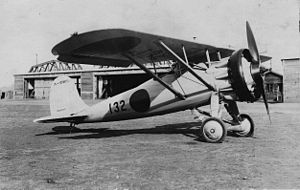- Nakajima Army Type 91 Fighter
-
Nakajima Army Type 91 Fighter Role Fighter Manufacturer Nakajima Introduction 1931 Retired 1937 Status out of service Primary user Imperial Japanese Army Produced 1931-1934 Number built 450[1] The Nakajima Army Type 91 Fighter was a Japanese fighter of the 1930s. It was a single-engine, single-seat parasol monoplane with a fixed, tailwheel undercarriage.
Contents
Development
Designed in response to an Army requirement of 1927,[2] the Type 91 was developed from the NC series of fighter prototypes. The prototype was the sixth machine under that designation but was a fundamentally distinct airframe design. Compared to the earlier NC, the Type 91 had a smaller wing, relocated fuel tank and wing-bracing struts, Townend ring-type cowling, new design tail and undercarriage.[3] It first flew in 1931.
Operational history
The Army ordered the new aircraft as the Nakajima Army Type 91 Fighter and the first deliveries took place late in 1931. However, issues arose with both directional stability and centre of gravity, with the result that the type was delayed entering service.
Between 1931 and 1934, 420 aircraft were constructed (including 100 by Ishikawajima; 23 of the total were Type 91-2, powered by a 432 kW (580 hp) Nakajima Kotobuki 2 radial engine. This version first flew in July 1934.
The Type was supplanted in service by the Kawasaki Army Type 95 Fighter in 1936-7.
Variants
- Nakajima Army Type 91-1 Fighter
- Main production version, powered by 336 kW (450 hp) Nakajima built Jupiter radial engine.
- Nakajima Army Type 91-2 Fighter
- Improved version, powered by Nakajima Kotobuki. 21 built.
Operators
- Kwangsi Air Force purchased two Type 91-1 fighters for evaluation in September 1934, with several more purchased in 1935.[4]
Specifications (Nakajima Army Type 91-1 Fighter)
Data from The Complete Book of Fighters [3]
General characteristics
- Crew: 1
- Length: 7.26 m (23 ft 9¾ in)
- Wingspan: 11.00 m (36 ft 1 in)
- Height: 2.79 m (9 ft 1¾ in)
- Wing area: 20.0 m² (215.28 ft²)
- Empty weight: 1,075 kg (2,370 lb)
- Loaded weight: 1,530 kg (3,373 lb)
- Powerplant: 1 × Bristol Jupiter VII 9-cylinder radial, 388 kW (520 hp)
Performance
- Maximum speed: 300 km/h (162 kn, 186 mph)
- Service ceiling: 9,000 m [1] (29,500 ft)
- Wing loading: kg/m² (lb/ft²)
- Power/mass: W/kg (hp/lb)
- Time to 3,000 ft (9,845 ft): 4.0 min
- Endurance: 2 hrs
Armament
2 × fixed, forward-firing 7.7 mm (.303 in) machine guns
See also
References
- ^ a b Mikesh, Robert C; Abe, Shorzoe (1990). Japanese Aircraft 1910-1941. London: Putnam Aeronautical Books. pp. 214–215. ISBN 0 85177 840 2.
- ^ "Virtual Aircraft Museum". http://avia.ltd.ee/air/japan/nakajima-91.php.
- ^ a b Green, William (1994). The Complete Book of Fighters. Smithmark. ISBN 0-8317-3939-8.
- ^ Andersson 2008, pp. 57–60.
- Andersson, Lennart (2008). A History of Chinese Aviation:Encyclopedia of Aircraft and Aviation in China until 1949. Taipai, Taiwan: AHS of ROC. ISBN 978-957-28533-3-7.
Aircraft produced by Nakajima Aircraft Company Imperial Japanese Navy types Imperial Japanese Army types World War II Allied reporting names Lists relating to aviation General Aircraft (manufacturers) · Aircraft engines (manufacturers) · Airlines (defunct) · Airports · Civil authorities · Museums · Registration prefixes · Rotorcraft (manufacturers) · TimelineMilitary Accidents/incidents Records Categories:- Japanese fighter aircraft 1930–1939
- Propeller aircraft
- High wing aircraft
- Single-engine aircraft
- Nakajima aircraft
Wikimedia Foundation. 2010.

